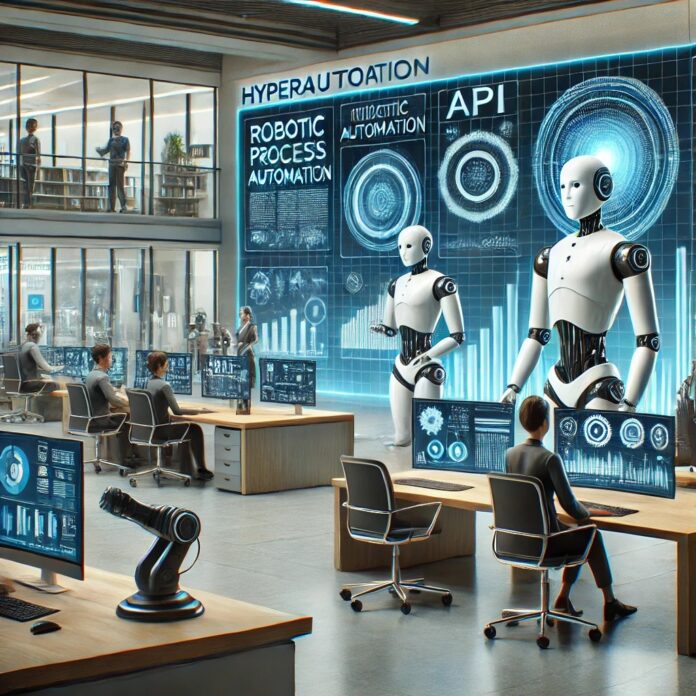Hyperautomation is transforming the landscape of business operations. By combining advanced technologies like artificial intelligence (AI), machine learning (ML), and robotic process automation (RPA), hyper-automation aims to automate complex business processes. This article will explore the concept, benefits, and challenges of hyper-automation, offering insights into its potential to revolutionize various industries.
What is Hyperautomation?
Definition and Core Components
Hyperautomation is an expansion of traditional automation processes, incorporating AI, ML, and RPA to enhance and automate complex tasks. It involves the use of various tools and technologies to augment human capabilities, making processes more efficient and less prone to errors. The core components of hyper-automation include:
- Robotic Process Automation (RPA): Automates repetitive tasks that do not require human judgment.
- Artificial Intelligence (AI): Provides cognitive abilities to machines, enabling them to make decisions and improve over time.
- Machine Learning (ML): Allows systems to learn from data and experiences, enhancing their performance.
How Hyperautomation Works
Hyperautomation works by integrating different technologies to automate end-to-end business processes. It begins with identifying tasks suitable for automation, followed by deploying RPA to handle repetitive activities. AI and ML are then applied to analyze data and make intelligent decisions, further refining the automation process. This continuous loop of improvement ensures that the system evolves and adapts to changing business needs.
Benefits of Hyperautomation
Increased Efficiency and Productivity
One of the most significant benefits of hyper-automation is the boost in efficiency and productivity. By automating mundane and repetitive tasks, employees can focus on more strategic and creative activities. This not only speeds up processes but also reduces the likelihood of errors.
Cost Reduction
Hyperautomation can lead to substantial cost savings for businesses. Automating tasks reduces the need for manual labor, cutting down on operational costs. Additionally, the increased accuracy and efficiency minimize waste and rework, further contributing to cost savings.
Enhanced Decision-Making
The integration of AI and ML in hyperautomation enables better decision-making. These technologies can analyze vast amounts of data, providing valuable insights and predictions. This data-driven approach allows businesses to make informed decisions, improving overall performance and competitiveness.
Challenges of Hyperautomation
Implementation Complexity
Implementing hyperautomation can be complex and challenging. It requires a thorough understanding of existing processes and the ability to integrate various technologies seamlessly. Businesses must invest in training and development to ensure employees are equipped to handle the new systems.
Security Concerns
With increased automation comes the risk of security vulnerabilities. Automated systems can be targets for cyberattacks, potentially compromising sensitive data. Businesses must implement robust security measures to protect their automated processes and data.
Workforce Displacement
Hyperautomation may lead to workforce displacement, as machines take over tasks traditionally performed by humans. This can result in job losses and require businesses to find ways to reskill and redeploy employees to new roles.
Real-World Applications of Hyperautomation
Financial Services
In the financial sector, hyperautomation is used to streamline processes such as loan processing, customer service, and fraud detection. AI and ML analyze data to make accurate credit assessments and identify fraudulent activities, while RPA handles routine transactions.
Healthcare
Hyperautomation in healthcare improves patient care and operational efficiency. Automated systems manage patient records, schedule appointments, and assist in diagnostics. AI-driven tools analyze medical data to provide insights into patient health, leading to better treatment outcomes.
Manufacturing
Manufacturing industries benefit from hyperautomation through enhanced production processes. Automated systems manage inventory, optimize supply chains, and monitor equipment performance. This leads to increased productivity, reduced downtime, and lower operational costs.
The Future of Hyperautomation
Continuous Evolution

The future of hyperautomation lies in its continuous evolution. As technologies advance, hyper-automation systems will become more sophisticated and capable. Businesses will need to stay abreast of these developments to fully leverage the potential of hyperautomation.
Integration with Emerging Technologies
Emerging technologies such as the Internet of Things (IoT) and blockchain will further enhance hyperautomation. IoT devices can provide real-time data for automated systems, while blockchain ensures secure and transparent transactions. The integration of these technologies will open new avenues for hyperautomation.
Human-Machine Collaboration
The future will see greater collaboration between humans and machines. Hyperautomation will not replace humans but augment their capabilities. Businesses will need to foster a culture of collaboration, ensuring that employees work alongside automated systems to achieve optimal results.
Conclusion
Hyperautomation represents a significant leap forward in business automation. By combining AI, ML, and RPA, it offers increased efficiency, cost savings, and enhanced decision-making capabilities. However, businesses must navigate the challenges of implementation, security, and workforce displacement. As technology continues to evolve, hyper-automation will play a crucial role in shaping the future of business operations, driving innovation, and competitiveness.



